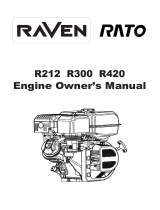
Gasoline Engine » Operator's Manual
SAFETY
OWNER
RESPONSIBILITIES
• The engines are designed
to
give safe and dependable service
if
operated according
to
instructions.
Read
and understand this
owner's manual before operating the engine. Failure
to
do
so
could result in personal injury
or
equipment damage.
• Know how
to
stop
the
engine quickly, and understand the
operation
of
all controls. Never permit anyone
to
operate the
engine
without
proper instructions.
• Do
not
allow children
to
operate the engine. Keep children and
pets
far
away from the area
of
operation.
SAFETY
PRECAUTIONS
A
DANGER
Indicate
a
possibility
of
invalid warranty
and
personal
or equipment
damage
if
instnictions
are
not
followed.
• Strictly
setthe
engine according
to
the regulated power on the
owner's manual. Do
not
overload, overrun
the
engine
or
run
it
with
low load and
at
low speed in a long time.
•
Use
specified grade
of
gasoline. The fuel should
be
fully
deposited and filtrated before
use.
Keep clean the fuel filler,
change the oil periodically.
• Periodically check
the
installation, connection and the degree
of
tightness
of
the
fixed bolt. Tighten
it
if
necessary.
• Periodically clean the element
ofthe
air cleaner, change
it
when
necessary.
• The engine
is
air-cooled,
so
clean the radiator, wind cover and
fan in time in
order
to
make the engine cool normally.
• The operator should
be
familiar
with
the working principle
aad
structure
of
the gasoline engine, knowing
how
to
make
an
emergent stop and
the
operation
of
all controlling parts. Any
one
without
training
is
forbidden
to
operate
the
engine. Keep
periodical maintenance. Solve problems in time. Do
not
nm
the
engine in spite
of
malfunction.
• Running die engine in a well-ventilated place, keep
it
at least
one meter away
from
building walls
or
other
equipments, keep
away
from
inflammables such
as
gasoline, matdies and
so
on
to
avoid possibility
of
fire.
• Refuel in a well-ventilated area
with
the engine stopped, and in
places refuelingorstoringgasoline, nosmokingand any flames
or
sparks.
• Refuel the fuel tank
not
too
full
so
as
to
avoid fuel's spilling out.
If
there
is
spilled fuel around,
be
sure
to
clean
it
thoroughly
before starting.
• Do
not
run the engine in airtight
or
ill-ventilated places.
• Inclination
of
gasoline engine which indicates
the
included
angle between crankcase cover and level
is
less
than 26°during
its runing.lf
that
is
over 26°, oil will
flow
into
combustion
chamber and burn
with
white
smoke, which
will
cause gasoline
engine
has
lower power and higher emission.
• Engine alone
or
assembled on
the ultimate machine, when
it
tilts
towards the air filter, the
angle should
not
beyond
26°,
or
oil would enter
the
air filter,
which affects operation (engine
tilts
towards the muffler,
the
angle should be
within
90°;
towards the cylinder head,
the
angle should
be
within
26°).
• Engine alone
or
assembled on ultimate machine, the angle
it
tilting
backwards should
not
beyond
26°,
or
it
would accelerate
gasoline leakage and affect operation.
• Safe warning label:
Please
carefully read warning label before
operating.
Our
company will
not
assume any responsibility
for
person hurt,
or
equipment damaged caused by disregarding
this warning label.
/ '
& WARNING
(~L1~&~
Read
pwner's
nual
Bel
re
Operation.
r -+
I Don't
br~ath
I
Please read the exhaustm
owner's manual
carefully before Please keep Don't operate
operating the fire far indoors.
away
\.
/
REFUEL
WITH
CARE
Gasoline
is
extremely flammable, and gasoline vapor
can
explode.
Refuel outdoors, in a well-ventilated area,
with
the engine
stopped. Never smoke near gasoline, and keep
other
flames and
sparks
away.
Always store gasoline in
an
approved container.
If
any fuel
is
spilled, make sure the area
is
dry
before starting
the
engine.
Safety I 4




















